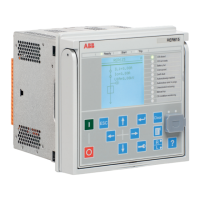PHIPTOC1
BLOCK
ENA_MULT
OPERATE
START
PHIPTOC1_OPERATE
PHIPTOC1_START
GOOSERCV_BIN
PHIPTOC_BLK
OUT
VALID
GUID-E9DCA896-69D8-4CAB-9E0A-766E26D4584D V1 EN
Figure 33: Adding the GOOSERCV function block
3. Create the connection into the application.
3.1. Create the connection.
3.2. Click Calculate execution order.
3.3. Click Validate configuration.
3.4. Save the connection to the application.
4. To open the Signal Matrix tool, right-click the protection relay, and select Signal
Matrix.
5. To map the input points to the receiving input data, click the cell.
To expand the source field, drag the edge of the field to expand it until the whole
GOOSE source address is visible.
6. In Signal Matrix in the GOOSE sheet, map the GOOSE publisher data into the
corresponding GOOSERCV function block.
The columns in the GOOSE sheet represent publisher data and the rows
represent the possible subscriber input point.
GUID-340E122B-E72E-4C70-90F5-DE15975CFFCF V2 EN
Figure 34: GOOSE sheet in Signal Matrix
The GOOSE receiver block output VALID defines the validity
for the received data. The value is based on the received quality
attribute value or communication status. This validity
information can be used in the application to build the validity
logic in addition to the GOOSE default supervision information.
1MRS757809 C Section 5
GOOSE
REC615 and RER615 51
Engineering Guide

